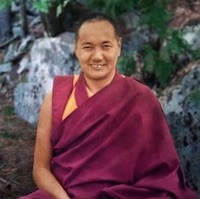
I’d like here to give just a brief introduction to tantra.
The first thing to understand is that Buddhism has broad and far-reaching array of teachings for human development. However, before we can begin actualizing the tantric path we need to understand the sutra path of human development, the three principal aspects of the path—Renunciation, Bodhicitta and universal reality or Shunyata—which is the main prerequisite for entering tantra.
With respect to Renunciation, we first need to understand the dissatisfactions and complications of our own daily life that result from ego conflict and that worldly wealth and pleasure are not the answer to the human search for satisfaction.Therefore Renunciation means avoiding the extreme of grasping at worldly pleasure and beginning to recognize that the source of everlasting satisfaction can be discovered within oneself.
In order to develop Bodhicitta, we also need to realize that the problem of human ego conflict is not just our own but a universal problem and therefore we feel sympathy for all living beings. His Holiness the Dalai Lama often talks about universal responsibility because if we’re too obsessed with our own problems, in our minds, they become bigger than the entire universe.
So the way to rid ourselves of the self-cherishing thought, which is the biggest obstacle to our developing Bodhicitta, is to change our attitude to one of dedication towards all living beings in the universe.
Sutrayana [the teachings or sutras of the Buddha associated with the hinayana and mahayana path of the Tibetan Buddhism] explains that self-cherishing is symptomatic of all human problems: when we seek pleasure motivated by self-cherishing, we mislead ourselves; what we get is increased misery. All problems, from those between a married couple to international conflicts, are all because of the self-cherishing thought.
[To totally get rid of self-cherishing we have to sever its root—dualistic concepts—which brings us to the third principal aspect of the path, the wisdom realizing emptiness, or Shunyata.
Dualistic concepts have to be understood by analyzing the ego conflicts in our own everyday life. Dual phenomena exist relatively but non-duality implies psychological contradiction or comparison.
Say our neighbor buys a car. We look at it and think, “I should get a car, too.” Then he gets a boat and we think, “I should have a boat as well.” Then he gets a second car and we think, “Why shouldn’t I get another car?” This is what I mean by contradiction; our restless mind is never satisfied with what we have.
That’s why when we seek good ideas in our materialistic environment we have to pay for them. This is because of the build up of duality, samsara and restlessness. Therefore the result is conflict: between parent and child, husband and wife, even food and stomach. Buddhism can explode such dualistic superstition and the function of meditation is to extinguish the restless dualistic mind.
So, if we have gained realizations such as those of the three principal aspects of the Sutrayana path, why do we need to actualize tantra?
Philosophically, Tantrayana is the vehicle by which humans can attain liberation most quickly but how quickly depends upon the individual practitioner. It takes much skill to utilize the powerful, sensitive tantric methods and techniques effectively.
One big difference between sutra and tantra is that Sutrayana emphasizes the faults of worldly pleasure whereas Tantrayana says that worldly pleasure can be the source of liberation.
 The Tibetan term for this concept is dö-yön-lam-khyer, which means, essentially, taking desire as the path to enlightenment. This indicates that the practice of tantra is very suitable to the materialistic life of the modern world, which is totally dedicated to the pursuit of pleasure, because all these modern objects of pleasure can be used to develop the path to liberation. This is an extremely practical approach to spiritual practice because we encounter these objects every day.
The Tibetan term for this concept is dö-yön-lam-khyer, which means, essentially, taking desire as the path to enlightenment. This indicates that the practice of tantra is very suitable to the materialistic life of the modern world, which is totally dedicated to the pursuit of pleasure, because all these modern objects of pleasure can be used to develop the path to liberation. This is an extremely practical approach to spiritual practice because we encounter these objects every day.
So rather than telling us to renounce pizza and mozzarella, tantra teaches us how to eat them in a positive way.
Italians have been eating pizza and mozzarella for centuries without knowing how; Tibetan monks have never eaten pizza or mozzarella but know how to do so!
Since every day we’re immersed in a materialistic environment and under the control of sense gravitation attachment, we can’t escape this situation; we’re born into it. Therefore it’s absolutely essential that we develop the skills to deal with this situation instead of being overwhelmed by it and find a realistic way of transforming our situation into the path to liberation or, at least, into a subdued and tranquil life. If we can learn to do that then it’s fine for us to enjoy our material life as much as possible.
It’s like certain poisonous plants will kill you if you eat them directly but with skill you can manipulate their negative energy and convert it to medicine. These days many people blame society and the environment for life’s ills but they’re wrong; it shows they don’t understand inner nature. From the Buddhist point of view, those who always blame external factors for their problems will never ever be able to solve them until they demolish such concepts.
According to tantric philosophy, as long as you harbor the misconceptions that make you interpret both yourself and the environment negatively and incorrectly there’s no way you’ll find true happiness.
And tantra also contains the methods whereby you can purify yourself of negative projections of yourself and the environment.
Practically speaking, human beings are responsible for their own body, speech and mind, to not give and to purify negative projections and to recognize the pure nature of their body, speech and mind. Therefore the practice of tantra involves transformation of body, speech and mind.
Read more of Lama Yeshe’s teachings at Lama Yeshe Wisdom Archive.
Relephant:
Introduction to Tantra: Second Teaching.
~
Author: Lama Yeshe
Editor: Travis May
Photo: Author’s Own








Read 0 comments and reply